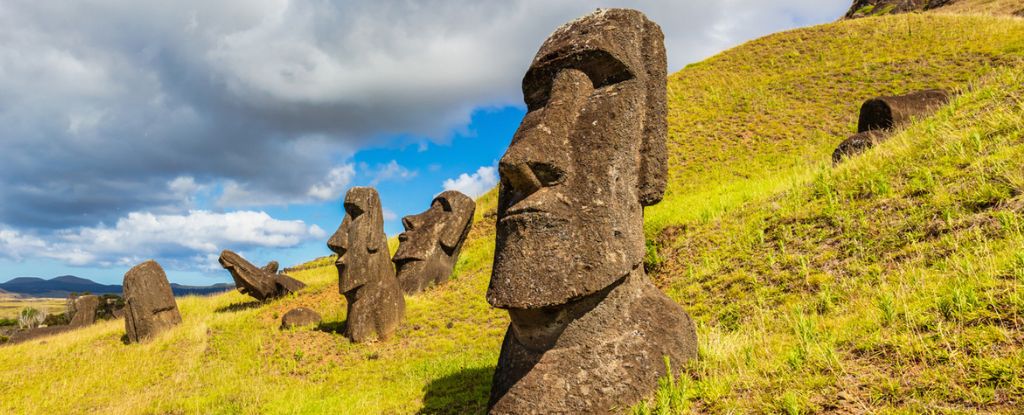Products You May Like
“In just a few centuries, the people of Easter Island wiped out their forest, drove their plants and animals to extinction, and saw their complex society spiral into chaos and cannibalism.”
So writes Jared Diamond in his best-selling book Collapse, which was published in 2005.
Nearly two decades later, an international team of geneticists has found evidence that this famous cautionary tale never actually happened.
The true story of Rapa Nui (named Easter Island by colonial Europeans) is not one of self-inflicted population collapse, the new findings suggest, but of cultural resilience.
In the 1600s, it seems that the ancient people of Rapa Nui were not utterly isolated on their island, and it is clear that they did not overexploit their resources to the point of ‘ecocide’.
Instead, ancient genetic data suggests the island was once home to a small population of between 1,500 and 3,000 individuals, who were interbreeding with populations that had Polynesian and Indigenous American ancestry long before Europeans had reached either region.
Genetic analysis indicates that Rapanui’s civilization was actually growing until the 1860s, when Peruvian slave raids and subsequent epidemics brought by European colonial activity decimated the island’s population to around 110 individuals.
Today, more than 1,500 people living on Rapa Nui identify as Indigenous Rapanui.
“These results do not support a major population collapse on Rapa Nui after its initial peopling and before the 1800s,” conclude the authors of the study, led by geneticists from the University of Copenhagen in Denmark and the University of Lausanne in Switzerland.
A large body of archaeological and anthropological data has already contradicted the ecocide theory of Rapa Nui. But this new research is the first to undermine the story using ancient genomic data.
The results are based on the remains of 15 ancient individuals from Rapa Nui, whose bones and teeth were taken by Europeans from the island in the 19th and 20th centuries and kept at several museums in Paris.
Under strict museum guidelines, researchers sequenced the genomes of each individual, with support from the Comisión de Desarrollo Rapa Nui (CODEIPA) and the Comisión Asesora de Monumentos Nacionales (CAMN).
The team also made sure to regularly meet with representatives of the Rapanui community. They hope their results will contribute to the community’s effort to repatriate their ancestors back to the island.
Based on the genomic analysis, which reconstructs the population of Rapa Nui over the last 100 generations, the researchers say it is unlikely that these individuals were born after European contact.
All 15 ancient Rapanui were found to have roughly 90 percent Polynesia-like ancestry. Their genes also carried around 10 percent Indigenous American ‘admixture’, an interbreeding event that likely occurred between 1250 and 1430.
Columbus did not reach the Americas until 1492, and European-like ancestry is only detected in present-day Rapanui, not in ancient Rapanui.
Today, Rapanui and Polynesian populations also carry an American Indigenous component, which studies suggest was mixed into both gene pools sometime between 1150 and 1495.
This indicates that Polynesian seafarers made it to the Americas and Rapa Nui before Europeans.
The only other ancient DNA studies of Rapanui conducted so far, however, found no trace of Indigenous American ancestry.
The leading authors of this most recent study, geneticists J. Víctor Moreno-Mayar, Anna-Sapfo Malaspinas, and Bárbara Sousa da Mota, explained to ScienceAlert that this was probably due to low resolution data and sampling errors.
When the team reanalyzed the ancient genomes from one past study, they detected an Indigenous American-like component in three out of five ancient Rapanui individuals.
Another past study, meanwhile, may have sequenced the genome of ancient Rapanui individuals who lived before this interbreeding event or right after it occurred, before the evidence was incorporated into their genome.
The new findings “leave no doubt” that ancient Rapanui interbred with populations of Indigenous American descent, write evolutionary archaeogeneticists Stephan Schiffels and Kathrin Nägele in an independent review of the study for Nature.
Now, the question is, how did the Rapanui make contact with Indigenous Americans on what Diamond once called “the world’s most isolated scrap of habitable land” – located roughly 1,800 km (1,100 miles) from the closest inhabited island in Polynesia and 3,512 km from Chile in South America?
For years now, experts have debated whether or not Pacific Islanders reached the Americas before Europeans.
In 2020, a genetic study found evidence that prior to the settlement of Rapa Nui, contact was made between Polynesians and Indigenous American groups most closely related to the Indigenous inhabitants of present-day Colombia.
“While it is true that long-distance sea voyaging became less frequent with time, we know that Polynesians were really adept seafarers that managed to get to every Polynesian island in a matter of 1 to 2 thousand years,” Moreno-Mayar, Malaspinas, and Mota explained to ScienceAlert.
“Since the sea was more a road to them rather than a barrier, we believe our results make it very likely that they managed to reach the Americas. Therefore, the data suggest that at some point, Rapa Nui was not as isolated despite the thousands of kilometers separating [it], other islands and the Americas.”
The study was published in Nature.
